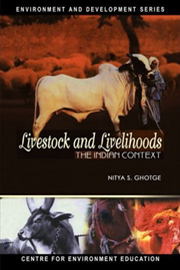Book contents
- Frontmatter
- Foreword
- Acknowledgements
- Contents
- Preface
- Chapter 1 The Beginning …
- Chapter 2 Patterns of Livestock rearing
- Chapter 3 Traditional Practices in Animal Rearing
- Chapter 4 Emerging Trends in Livestock Rearing
- Chapter 5 It must not End: Towards an Alternative Policy
- Chapter 6 Reorienting Ourselves
- Chapter 7 Framework for An Alternate Policy
- References
- Index
Chapter 1 - The Beginning …
Published online by Cambridge University Press: 26 October 2011
- Frontmatter
- Foreword
- Acknowledgements
- Contents
- Preface
- Chapter 1 The Beginning …
- Chapter 2 Patterns of Livestock rearing
- Chapter 3 Traditional Practices in Animal Rearing
- Chapter 4 Emerging Trends in Livestock Rearing
- Chapter 5 It must not End: Towards an Alternative Policy
- Chapter 6 Reorienting Ourselves
- Chapter 7 Framework for An Alternate Policy
- References
- Index
Summary
The Domestication of Animals
The story of the domestication of animals is over 14 thousand years old. It is believed that the first animals to be domesticated were dogs, presumably as companions to the human race during hunting. Through the years, different species have been domesticated in different parts of the world from their wild progenitors to cater to different human needs of food, fibre, fuel, medicine and transport. In some cases these animals have spread throughout the world. For example, cattle, goats and sheep. In others, they have remained localized in their region of origin like the alpaca, llama, and yaks. Yet others are in a state of semi-domestication like the elephant, mithun, mink and silver fox.
The region of domestication and the need for domestication have given rise to certain distinct patterns of livestock farming. A large number of animals were domesticated around the grasslands of West and Central Asia. These were mainly from the herbivorous species that ate grass: sheep, goats, cattle, horses and camels. Early cattle, sheep and goat rearers were migratory and herded their animals in search of grasslands. When the pressure on grasslands became too much, they migrated in search of fresh pastures or invaded fresh territory. Many major invasions including those of the Mongols are attributed to times when the pressure on grasslands became excessive.
In contrast, species of the forest like the elephant, the water buffalo, pigs and chicken were first domesticated in the region of South Asia and Indo-China in areas which were heavily forested and where plenty of water was available.
- Type
- Chapter
- Information
- Livestock and LivelihoodsThe Indian Context, pp. 3 - 6Publisher: Foundation BooksPrint publication year: 2004

